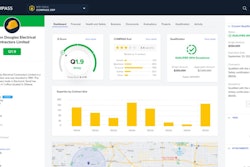
If you hire a subcontractor who either doesn’t carry workers’ compensation or who doesn’t have the right kind of coverage your business could suffer the consequences. Two of the biggest and most detrimental risks include financial expense to your company and worker limitations.
Murray Rice of Richard and Rice Construction shared his insights on the dangers of inadequate or non-existent coverage, as well as tips for verification and company protection.
Financial Risks for GCs
If you’re a construction company owner who hires a subcontractor without proper workers’ compensation and your workers’ compensation policy winds up having to cover an accident, your rates could increase significantly. Additionally, you will have to pay the deductible out of your own pocket. Rice explains that these deductibles can be thousands or even tens-of-thousands of dollars. The effects of not making sure your subcontractors carry their own workers’ compensation policies can demolish your bottom line.
Other expensive problems occur when you hire a subcontractor who uses their own additional workers without telling you. This prevents you from verifying every worker on a project is covered. If any of these workers are hurt on the project, your policy could wind up having to cover them.
Workers’ Comp Policy Exclusions
Another major problem with improperly covered subcontractors involves workers’ compensation policies that enforce residential exclusions, Rice says. These exclusions prevent policyholders from working on residential construction projects. “Sometimes the residential exclusion is structured in a [way that says] you only have coverage for the first 20 units. So, if you're working on a community project and [a subcontractor] builds the first 20 houses, [they only] have liability coverage on those first 20. After that, there is no coverage,” he says.
As Rice explains, this type of policy is virtually useless in the construction industry – because community projects can quickly exhaust an exclusionary policy. At that point, construction managers must let that subcontractor go.
General Contractors Must Verify Workers’ Comp Coverage
Rice stresses the importance of verifying every subcontractor you hire is comprehensively covered by their own workers’ compensation coverage. You need to make sure:
- Subcontractors have a workers’ compensation policy.
- Their policy includes adequate coverage amounts.
- The policy does not have exclusions that would impact your projects (such as residential exclusions).
Remaining fully aware of all workers on your projects is also an important aspect of workers’ compensation verification. Subcontractors often hire additional workers so they can finish more quickly. Rice advises requiring accurate, transparent reporting of all workers on any project. Rice has site managers conduct headcounts and requires sign-ins to keep job sites free of unapproved workers. Doing this allows you to verify that each person on the project is covered by his or her own policy or by the subcontractor’s policy.
Some of the specific ways Richard and Rice Construction verifies adequate workers’ compensation coverage include:
- Requiring copies of all subcontractors’ workers’ compensation policies and insurance contracts.
- Reading through the policies to verify they cover all necessary work – such as residential, carpentry, masonry and the like.
- Contacting workers’ compensation vendors listed on policies and requesting declaration pages directly from them.
- Having subcontractors turn in payroll paperwork so Richard and Rice can make sure all workers have been approved to work on their projects and are covered by workers’ comp.
- Tasking foremen with performing job site audits to check for unapproved workers.
Organization Is Crucial
Keeping up with subcontractor workers’ compensation coverage can seem daunting – but implementing organizational practices can streamline the process. Rice says his company hired a full-time employee whose entire job is to verify workers’ compensation coverage and other paperwork for every subcontractor hired.
Richard and Rice Construction also uses a company app for project management in which all workers reported by subcontractors are highlighted – so superintendents can verify that only approved individuals are on the job site each day.
Many construction company owners have spent a lifetime building their businesses. Making these adjustments may require a time commitment, but they can save you thousands in the long run. They may even protect you from losing your business completely.


















